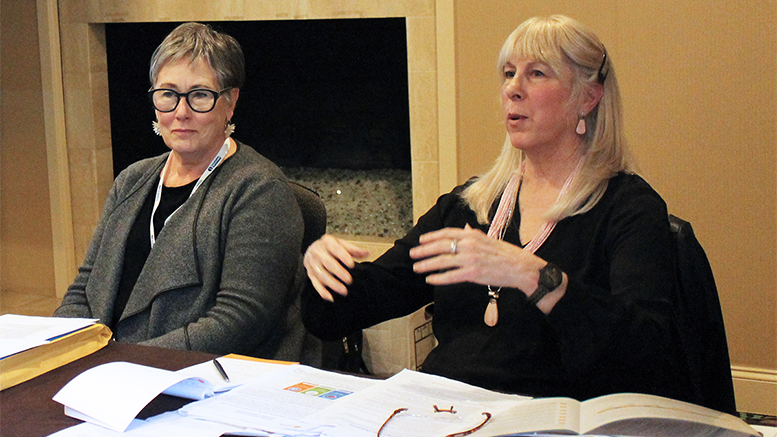NEWPORT BEACH, Calif. — Several national initiatives are under way to bring some clarity to the concepts of competencies and credentials – and connect them in a meaningful way.
Officials from the American Association of Community Colleges and other organizations described their work at AACC’s Workforce Development Institute.
AACC’S Right Signals initiative is aimed at building a new credentialing model that brings a common language and transparency to the array of existing credentials, such as degrees, certificates, apprenticeships and industry certifications. Twenty community colleges are participating in this effort.
Lumina Foundation, which is funding Right Signals, is building on its efforts to spark a national dialogue on what credentials really mean. That effort led to a prototype for a national registry of credentials called Credential Engine. That initiative, said strategy director Holly Zanville, is based on the foundation’s goal of ensuring 60 percent of Americans have a degree, certificate or other postsecondary credential by 2025.
Because “not everything you learn is in the classroom,” Zanville said, the foundation is working on models for a new “learning passport,” that would capture all student records in an extended transcript, along with a record of what was learned on the job
Dozens of colleges, industry groups that confer certifications and other organizations have joined Credential Engine, a nonprofit organization created to scale up the registry. In September, Credential Engine introduced a prototype search engine app called Workit.
Bringing order
Lumina partnered with the Corporation for a Skilled Workforce (CSW) to bring order to the chaotic credentialing marketplace through a tool called the Connecting Credentials Framework. The eight-level framework, currently undergoing beta testing, is a reference tool to build profiles of industry certificates, licenses and other types of credentials, said Susan Lupo, senior policy associate at CSW.
Connecting Credentials aims to produce the process and tools that align a curriculum to job tasks; articulate pathways; create a common language; align programs, courses and assessments; develop instruction; validate credential quality; embed credentials in transcripts; reduce silos; and enhance transparency.
“It allows for a way to think about connections,” Lupo said. It’s all about “the skills human beings need in the workplace,” and it’s based on the concept that “competencies are currency.”
Pathways to employment
“Every student is ultimately seeking a job,” said Kay McClenney, senior advisor to the president of AACC.
McClenney is interested in seeing how the efforts to develop frameworks around workplace competencies tie in with AACC’s work on guided pathways. “My task is to reinforce these important connections,” she said.
Two of the colleges in Right Signals – South Seattle College in Washington and Columbus State Community College in Ohio – are also participating in AACC’s Pathways Project. At the heart of the pathways concept is the creation of curriculum maps that outline the steps from when students enter college to the completion of a credential.
“We’re not interested in building six-lane highways into a swamp. We want to create real opportunities that lead to transfer or a job,” McClenney said.
The idea is to start with the end in mind – the labor market or a university – and design a curriculum to get there, she said. “The most common outcome is the accumulation of credits and debt and no credential. Pathways is intended to fix that,” she said.
Most institutions haven’t done a good job of equipping students to make an informed choice about careers and pathways, McClenney noted. Colleges in the Pathways initiative are helping students do that by strengthening their advising services.
The colleges also are working to identify a default set of courses for all students within a career cluster, or “meta-major,” such as business or social science, she said.
A growing number of colleges are helping students navigate this process by designing websites that show the sequences of courses for meta-majors and describe what students will learn, what it’s like to work in that area, what the job outlook is, and what salaries employees can expect to earn with various credentials.
In the design of pathways, McClenney is urging colleges to incorporate more opportunities for applied learning, such as internships, project-based learning, field work and clinical placements.
Equity concerns
Even though some college completers with certificates land high-paying jobs, there is still a strong relationship between educational attainment and earnings, McClenney said. As a result, she urges college leaders to pay attention to equity issues, noting that minorities are still overrepresented in fields that lead to lower-paying jobs.
“We have to be careful to ensure that pathways don’t become another type of 1950s-style tracking,” she warned.
A high-value degree or certificate must lead to high-value employment or further education, Zanville agreed. “We don’t want to see people dead-ended,” she said.
In response to concerns that young people can’t be expected to make a career decision that will affect the rest of their life, McClenney said, “it’s better to get into a pathway and meta-major and stay in school to completion than to wander around decision-free and end up with nothing.”
McClenney would like to see colleges get more efficient at prior-learning assessments, so students on a pathway could progress faster from basic courses to college-level courses.
“We need to check our assumptions about everything,” Lupo said. “The path is not linear.”
AACC would like to see dual-enrollment students be included in outcome measures and noncredit students be eligible for federal financial aid, added Kent Phillippe, associate vice president for research and student success at AACC.
According to Phillippe, “Pathways and Right Signals are shining a light on how we can help colleges be more effective.”

